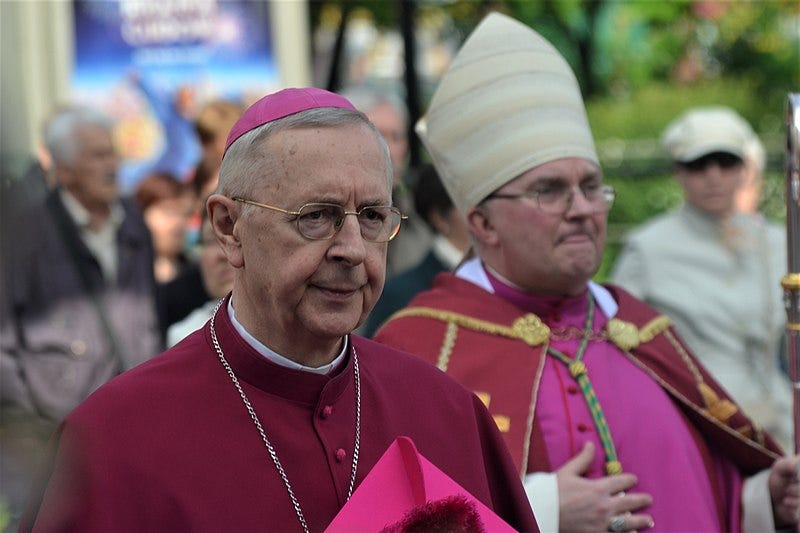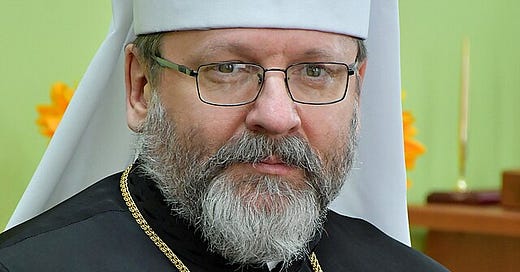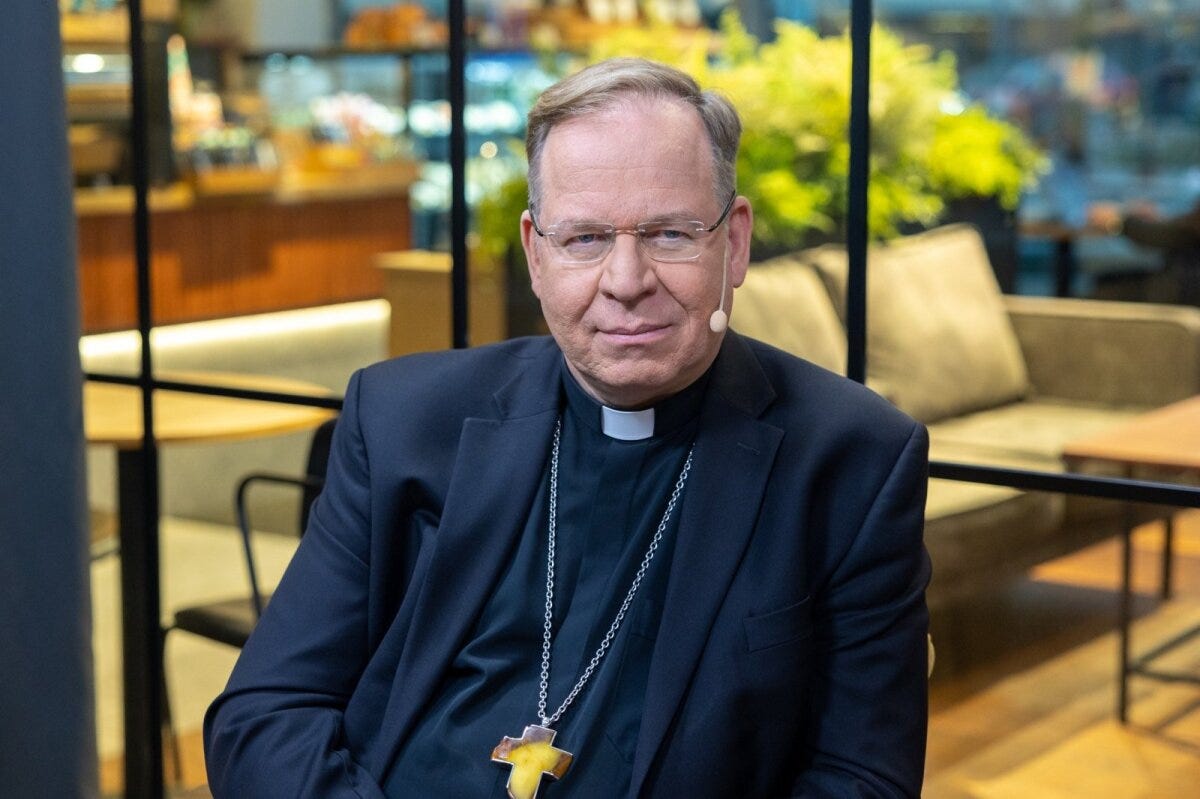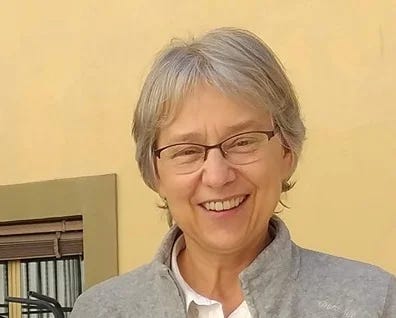This is the twelfth and final article in an occasional series exploring the contributions of different parts of the globe to the upcoming Synod on Synodality in October.
The European continental document, written in preparation for the Synod on Synodality, notes that the European continent’s geography reflects its diversity—the differences between East and West, as well as between North and South (15). Although representatives of the Catholic Church from throughout Europe gathered together at the Continental Assembly in February of this year, that diversity is nevertheless reflected in the different responses to the synodal process.
In the previous two essays in my Synod on Synodality World Tour (here and here), I surveyed the Synod participants from Western Europe. In today’s article, I will look at the participants from Eastern Europe. Although I split the participants up in this way for the more mundane reason that there were too many to consider in just one (or even two) articles, I think the division still helps illustrate the different cultural and religious backgrounds of the two regions and the distinct ways the participants can contribute to the Synod.
As I noted in my first post on participants from Western Europe, I am defining “Western” and “Eastern” Europe using the old Cold War boundaries, which remain culturally relevant even if politically obsolete. I am also including Turkey and Cyprus as part of Europe rather than the Middle East.
The ongoing war in Ukraine weighs heavily over the Church in Eastern Europe and has impacted the synodal process. For example, Oleksandr Yazlovetskiy, the Latin Auxiliary Bishop of Kyiv-Zhytomyr, has noted that the invasion of Ukraine by Russia, which began in February of 2022, made it difficult to carry out the synodal process at the national level. Nevertheless, he adds, it had the practical effect of drawing priests and bishops closer to the people, through seeking refuge in shelters or working together in volunteer efforts.
The Synod delegates from Ukraine have been outspoken in their condemnation of Russia’s invasion, but also in their class for peace. For example, Sviatoslav Shevchuk, the Major Archbishop of Kyiv-Halyc and head of the Ukrainian Greek Catholic Church, was sharply critical of Russia’s invasion, but has also continued to lead the people of Kyiv in prayers for peace and spiritual strength as the war lingers on. Yazlovetskiy visited Washington, DC in January of this year, sharing the experience of Ukrainians and seeking aid from Americans.
It is not just the Ukrainian delegates for whom the war looms large; Church leaders from other Eastern European nations that feel threatened by Russian imperialism have also spoken out forcefully against Russia’s invasion and even criticized the Vatican’s lukewarm response in the early months of the war. For example, Stanisław Gadecki, the Archbishop of Poznań and president of the episcopal conference of Poland, wrote a letter on behalf of the conference condemning Russia’s actions and expressing solidarity with Ukraine immediately after the invasion. Archbishop Gintaras Grušas of Vilnius, Lithuania, the president of the Council of Bishops’ Conferences of Europe, has criticized the Vatican’s initial impulse to try to mediate the conflict at the expense of clearly identifying the aggressor and victim.
That being said, the tiny Latin Catholic community in the Moscow region of Russia, organized under the Archdiocese of the Mother of God at Moscow, will also be represented at the Synod. The single delegate from Russia is Oksana Pimenova, the coordinator of the Archdiocese’s Youth Center and the deputy director of the St. Thomas Institute, a center founded in 1991 and run by the Jesuits that offers courses in theology. Pimenova participated in drafting the national document for Russia as part of the synodal process and represented Russia as a delegate at the Continental Assembly. In the Russian national document, the drafters concluded that Russians should be willing to “touch the wounds” on both sides of the conflict and work for peace.

The religious context of Ukraine is also representative of much of Eastern Europe: distinct religious traditions, even distinct Christian traditions, overlapping with one another, sometimes living in peace, sometimes living with tensions. A large majority of Ukrainians are Eastern Orthodox. The Orthodox in Ukraine, however, are split between the majority who belong to the Orthodox Church of Ukraine, an autocephalous (self-governing) church recognized by the Ecumenical Patriarch of Constantinople, Bartholomew I, and established in 2018, and a smaller number who belong to the Ukrainian Orthodox Church, which is under the authority of the Russian Orthodox Church. Archbishop Shevchuk, the head of the Ukrainian Greek Catholic Church, has noted that the creation of the former has improved ecumenical relations in Ukraine, and early in the conflict, Shevchuk met with his counterpart, Metropolitan I Epiphanius of Kyiv and All Ukraine, to discuss how the two churches could cooperate in the midst of war.
Ukrainian Catholics are also divided into a number of groups. The largest is the Ukrainian Greek Catholic Church, of which Shevchuk is the head, which is in fact the largest Eastern Church in the Catholic communion. Its origins are complex. At the Union of Brest in 1595, the majority of Orthodox in the eastern part of the Polish-Lithuanian Commonwealth (a country established through the merging of the Kingdom of Poland and the Grand Duchy of Lithuania) decided to declare their loyalty to the pope, establishing the Ruthenian Church. With the partition of the Commonwealth in the 18th century, much of what is today Ukraine came under the control of the Russian Empire, and throughout the 19th century, the Greek Catholic churches in the region were taken over by the Russian Orthodox Church, although they continued to exist in territories controlled by the Austrian Hapsburg Empire (and later Hungary, Czechoslovakia, and independent Poland). After World War II, much of the region of Poland that was home to Ukrainian Catholics was taken over by the Soviet Union, as part of the “republic” that is now independent Ukraine. In 1963, Pope Paul VI created an autonomous Ukrainian Greek Catholic Church, although it was not officially recognized by the Soviet government until 1989.
In addition to Shevchuk, the Ukrainian Greek Catholic Church will be represented at the synod by Teodor Martynyuk, the Auxiliary Bishop of Ternopil-Zboriv, in the western part of Ukraine. Like many Eastern Catholic Churches, the Ukrainian Greek Catholic Church has a significant diaspora, and it will be represented by Bohdan Dzyurakh, C.Ss.R., the Apostolic Exarch of Germany and Scandinavia.
Those Ruthenians who fell under the authority of the Hapsburg Empire after the partition of Poland established the Eparchy of Mukachevo in 1771. This territory was variously under Hungarian and Czech control until after World War II, when it, too, came under Soviet control and eventually became part of Ukraine. The Eparchy was dissolved in 1949 but revived in 1989. The Ukrainian Eparchy of Mukachevo, together with the Metropolis of Pittsburgh (which serves Ruthenians throughout North America), make up the Ruthenian Catholic Church. At the upcoming Synod, the Eparchy of Mukachevo will be represented by Maria Sabov, a teacher at a high school in the town of Beregovo, near the border with Hungary, who was likewise a participant at the European Continental Assembly.
Ruthenian Catholics make up only a tiny portion of Ukraine’s population, as do Latin Catholics. In addition to Yazlovetskiy, the Latin Church in Ukraine will be represented at the Synod by Radosław Zmitrowicz, O.M.I., the Auxiliary Bishop of Kamyanets-Podilskyi. Originally from Poland, Zmitrowicz served as a missionary to Turkmenistan before being stationed in Ukraine in 2000, and he was appointed auxiliary bishop in 2012. Although his diocese, in the western part of the country, is far from the battlefield, it has nevertheless been affected by the war. Family members have joined the fighting, with many dying, and thousands of refugees from eastern Ukraine have fled to the region. Zmitrowicz has led the Church’s efforts in responding to these different needs.
The Hungarian and Slovak Greek Catholic Churches, like the Ukrainian Greek Catholic Church and the Eparchy of Mukachevo, trace their origins back to the Ruthenian Church formed at the Union of Brest. The majority of Hungary’s Christians are Latin Catholics, but a small minority, particularly in the northeastern part of the country, belong to the Hungarian Greek Catholic Church. They will be represented at the Synod by Fülöp Kocsis, the Metropolitan of Hajdúdorog, who met with Pope Francis on his visit to Hungary earlier this year.. Roman Catholics in Hungary will be represented by Gábor Mohos, the Auxiliary Bishop of Esztergom-Budapest, who serves under the influential Cardinal Péter Erdő, the Archbishop of Esztergom-Budapest.
As in Hungary, the majority of Christians in Slovakia are Roman Catholics. They will be represented at the Synod by Marek Forgáč, the Auxiliary Bishop of Košice. As I have noted throughout this series, the formation of seminarians is likely to be a topic of interest at the Synod, and before his appointment as bishop, Forgáč developed an “integral model” for evaluating candidate for seminary formation, including spiritual and psychological elements. The Slovak Greek Catholic Church will be represented by Milan Lach, S.J., who was appointed Auxiliary Bishop of Bratislava only this year. From 2018 to 2023, he served as the Eparch of Parma, Ohio for Byzantines, serving Ruthenian Greek Catholics in the Midwest. Lach generated controversy in that role by initiating a process of parish mergers and bringing in priests from Europe to serve congregations in the United States.
The Romanian Greek Catholic Church was established in 1698 through an Act of Union with Rome. It will be represented at the Synod by Cristian Dumitru Crişan, the Auxiliary Bishop of Făgăraș and Alba Iulia. Latin Catholics in Romania will be represented by Gergely Kovács, the Archbishop of Alba Iulia, and József-Csaba Pál, the Bishop of Timişoara. Unlike Hungary and Slovakia, Romania is overwhelmingly Orthodox, and so both Latin Catholics and Greek Catholics are relatively small populations in Romania.
The Catholic Church in Albania is a church that lives in a diverse context but is in some ways thriving under Francis’s pontificate. Over half the population of Albania is Muslim, about 10 percent is Catholic, and about 7 percent are Orthodox according to the 2011 census, although those numbers are disputed. The Church in Albania is led by Arjan Dodaj, F.D.C., the Archbishop of Tiranë-Durrës, who has an interesting life story. After the fall of the country’s communist system in 1990, the country was swept by political and economic turmoil, and a large wave of migrants began leaving the country in 1991, particularly for Italy. Dodaj, only a teenager at the time, was among them, leaving for Italy in 1993. An atheist, Dodaj fell in with a group of Italian Catholic youth, and he was baptized in 1994. He eventually entered the seminary and was ordained in 2003.
After having served as a priest in Italy for years, Dodaj was asked by the Archbishop of Tirana-Durrës in 2017 to return to Albania and serve as his vicar general. He was appointed auxiliary bishop in 2020 and then archbishop the following year. When he returned to Albania, Dodaj found the Church thriving, in contrast to the sorry state of things under communist oppression: churches were full, and young people were engaged in the life of the church. He hopes to nurture what he calls a “living Church.” His experience as a migrant has also led him to call on Europeans to have compassion on today’s migrants, including those from Africa and the Middle East. Dodaj has also participated in interreligious dialogue with Albania’s Muslims and Orthodox Christians.
Gjergj Meta, the Bishop of Rrëshen, is the other Synod participant from Albania, and his leadership also reflects aspects of Francis’s style. Meta has stood up to organized crime and sex trafficking in Albania. Citing Pope Francis, he has also called for the Church to be a church of the poor that reaches out to people on the peripheries. His leadership also reflects synodality; he has emphasized the baptismal mission of all the faithful, as part of the People of God.
Gintaras Grušas, the previously-mentioned Archbishop of Vilnius, Lithuania and president of the Council of Bishops’ Conferences of Europe (CCEE), also has a compelling life story. His parents were separated during World War II, his father fleeing to the United States while his mother and sister were left behind in the Soviet Union. Sixteen years later, they were reunited in Washington, DC, and Gintaras was born soon after. Growing up in Los Angeles, he attended college at UCLA. After a few years working at IBM, he felt a calling to the priesthood, with the goal of serving Lithuanians abroad. He attended seminary for one year at the Franciscan University of Steubenville, but then he transferred to the Angelicum in Rome. Upon completing his studies in 1994, he was ordained a priest in the Archdiocese of Vilnius.
He began working on the staff of the Lithuanian episcopal conference that same year. A few years later, he experienced a rapid rise in the ecclesial hierarchy. In 2010, he was appointed the military ordinary for Lithuania. In 2013, he was named the Archbishop of Vilnius, and the president of the Lithuanian episcopal conference the following year. In 2021, he was elected the president of the CCEE. In that role, he has helped guide the synodal process on the European continent.
.The Polish bishops attending the Synod reflect contrasting leadership styles. Stanisław Gadecki, the already-mentioned Archbishop of Poznań and president of the Polish episcopal conference, has adopted what Americans might identify as a “culture warrior” style of episcopal leadership. He has spoken out against proposals to recognize civil unions and to assist couples pursuing in vitro fertilization, and even opposed Poland’s entry into a Council of Europe convention on violence against women and domestic violence because it included language about “socially constructed” gender roles. Marek Jedraszewski, the Archbishop of Kraków, has perhaps taken an even more strident tone, taking a highly confrontational stance against LGBTQ rights: “The red pestilence no longer marches across our land, but a new, neo-Marxist one has appeared, which seeks to conquer spirits, hearts and minds — not red, but rainbow.” Jedraszewski has even rejected Halloween as an “anti-Christian” holiday.
Although without necessarily intending to become involved in politics, the approach taken by bishops like Gadecki and Jedraszewski has lent support to the conservative governing Law and Justice party and President Andrzej Duda. To his credit, Gadecki has called on the Polish government to do more to welcome refugees, not only from neighboring Ukraine and Belarus, but also from Africa and the Middle East, in contrast to some other bishops in Eastern Europe who have been hostile toward refugees.
Gadecki has also been critical of the German Synodal Way. In February of 2022, he wrote a lengthy letter expressing his concerns about the direction of the Synodal Way, which was followed a month later by a letter from the bishops of the Nordic countries. In regards the upcoming Synod, although he has expressed support for the idea of synodality, he has said that the Synod cannot be thought of as a democratic process in which the majority rules, but rather a process requiring discernment.
In contrast, Cardinal Grzegorz Ryś, the Archbishop of Łódź, has expressed strong support for synodality. He has suggested that synodality requires shared responsibility between clergy and laity and the rejection of clericalism. Similarly, Adrian Józef Galbas, S.A.C., the Coadjutor Archbishop of Katowice, has said that priests and bishops should not be treated as “sacred cows” who cannot be questioned or who must be in charge of everything. Echoing Francis, he has stated that his pastoral goals are reaching out to those at the peripheries and addressing the wounds in the Church, particularly those caused by abuse. In that same interview, he made some humorous remarks about artificial intelligence I thought were worth quoting, considering the attention I’ve given that topic in this newsletter:
The sermon that AI will write for me will probably be better than the sermon that I write for myself, but artificial intelligence will not be able to evangelize because it has never met Christ, never loved Him, never believed in nor needed Him, neither now nor ever. . . . It will not absolve me either, although in the confessional, it will probably give me more thoughtful advice than many priests.

I’ll round out this survey with a few more intriguing Synod participants. Perhaps the most “larger than life” is Cardinal Konrad Krajewski, the papal almoner since 2013 and more recently the Prefect of the Dicastery for the Service of Charity. Beginning his Vatican career as Papal Master of Ceremonies from 1999 to 2013, during the papacies of John Paul II and Benedict XVI, since then Krajewski has been known for his daring, perhaps even reckless, acts of charity.
In 2019, Krajewski climbed down a manhole to restore power to a building inhabited by about 450 homeless squatters, including 100 children. To do so, he had to illegally reconnect the building to the main power supply. This deed aroused the wrath of Matteo Salvini, the populist political leader and then-deputy prime minister, who quipped that he would send Krajewski the bill, which Salvini claimed was the equivalent of over $300,000. Krajewski responded that he would be willing to pay the bill, but he pointed out that the livelihood of the people, especially the children, should be a higher priority than money.
The next year, Krajewski provided financial assistance to a community of about 20 transgender women, many of whom were sex workers, in the town of Torvaianica, after they had lost their livelihoods because of the COVID-19 pandemic. The group had sent a letter requesting help from Pope Francis at the suggestion of a local priest, who had been trying to help the group. Once this assistance became public knowledge, it generated controversy, but Krajewski explained, “This is ordinary work for the Church, it’s normal. This is how the Church is a field hospital.”
Most recently, Krajewksi has taken several trips bringing humanitarian aid from Rome to Ukraine, at extreme personal risk. This aid has included medicine and medical supplies, an ambulance, and thermal shirts for winter.
The Synod bishops from the Eastern Mediterranean have interesting backgrounds. Like the bishops in Albania, Massimiliano Palinuro, the Apostolic Vicar of Istanbul, Turkey, works in a predominantly Muslim country, leading the Latin Church there. Originally from southern Italy, Palinuro began working as a missionary in Turkey in 2011. Selim Jean Sfeir is the Archbishop of Cyprus of the Maronites. Sfeir is originally from Lebanon but has been involved in pastoral ministry in Cyprus since 2007. He was appointed archbishop in 2021. The Lebanese population on Cyprus has grown since the economic and political crisis that began in 2019, making Sfeir’s position all the more important. Sfeir greeted Pope Francis on his visit to Cyprus and Greece in 2021.
Manuel Nin, S.D.B. is the Apostolic Exarch for Catholics of the Byzantine Rite in Greece. Originally from Spain, he joined the Benedictines early in his life, and then went on to study Patristics in Rome. Having fallen in love with Eastern Christianity, he eventually became a consultor for the Congregation (now Dicastery) for Eastern Churches. Ordained a priest in 1998, he joined the Melkite Greek Catholic Church in 1999. He was named Apostolic Exarch in 2016. More recently, he has claimed that the synodality represented by the upcoming Synod is different from synodality in the Eastern Churches; whereas in the latter synodality is a collective decision-making process undertaken by the bishops, in the former it appears to be an open-ended, almost “parliamentary” process including both laity and clergy. As the continental document from the Middle East pointed out, however, historically even in the East, synodality involved laity and religious in the decision-making process. In representing Greece, Nin is joined by Georgios Altouvas, the Archbishop of Corfu, Zante, and Cefalonia, one of the Latin bishops of Greece.
Sr. Jolanta Maria Kafka, R.M.I. from Poland is the superior general of the Claretian Missionaries. She also served as the International Union of Superiors General until 2022.
And finally, the Eastern European delegation includes two philosophers and theologians. Aleksander Bańka is a Professor of Philosophy at the Faculty of Humanities of the University of Silesia in Katowice, Poland. His work focuses on the philosophy of two early 20th century Belgians, Cardinal Désiré Mercier and the philosopher Joseph Maréchal, SJ, both of whom offered contrasting efforts to respond to Kantian idealism from within a neoscholastic framework. Bańka’s work also focuses on developing a philosophy of mysticism. Dr. Klára Antonia Csiszár is a Romanian scholar working at the Catholic Private University Linz, Austria as a Professor of Pastoral Theology. Her work focuses on missiology and the study of the Church in Romania.
The Synod delegation from Eastern Europe is heavy on bishops while lacking examples of priests, religious, or lay people engaged in other forms of pastoral ministry or social activism, especially when compared to Western Europe. The Eastern European delegation does bring with it the riches of the traditions of both the Latin and Eastern Churches, as well as a wealth of experience in dealing with religious diversity, ecumenism, and interreligious dialogue. In countries like Poland and Albania, there is also a Catholic population eager for participation in the life of the Church. Bishops like Archbishop Grušas of Vilnius, Bishop Meta of Rrëshen, and Archbishop Ryś of Łódź, have enthusiastically supported synodality, while others like Archbishop Gadecki of Poznań and Exarch Nin have raised some perhaps valid cautions about the process.
Having now surveyed all the continental documents and Synod participants, all that’s left is to let the Synod unfold!






